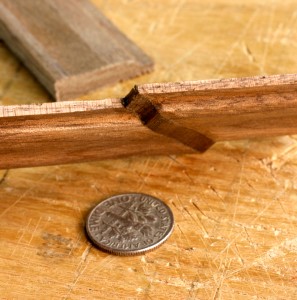We may receive a commission when you use our affiliate links. However, this does not impact our recommendations.
I spent much of Friday in the shop, tuning up machines in preparation for an upcoming magazine project. The thing I will be building is rather small, but with some involved details. I wanted the table saw and router table to be as precise as possible, and I also wanted to get some practice in on a couple of parts of the project. Many woodworkers are reluctant to get in woodworking practice, but if I have a fussy detail, and I’m not sure of the best way to do it, an hour or two going through the steps can make a huge difference in the final outcome.

This image is about twice the actual size on my monitor. Click on the image for an even larger version. I sure wish I could do that while working on it.
Friday’s problem came in two parts: I needed to make a little bitty moulding, and I needed to decide how to cut mitered returns in it. It’s not a detail I would include, but I’m building a reproduction so my choice is to suck it up and do it right or take the easy way out and leave out an important visual element. On my screen, the moulding in the photo is about twice its actual thickness, 7/32″. It steps in and out as it goes around the perimeter of a piece that’s around 4″ wide and about 11″ long – 24 mitered corners to cut and fit. I’m also planning to make several iterations of this piece, so I need an efficient method.
I’ve worried more about this element of the project than any other. I spent more time searching in vain for an existing router bit than it took to make a sample with two bits we had on hand and some handplaning at the transitions. My quest for the router bit was driven by my desire to use a single piece of wood to avoid mitering every corner. But that would mean a good deal of hand work to square off the rounded inside corners. A short conversation with a good friend who knows his stuff led me to abandon the router-only approach.
It turns out it isn’t that hard. I have some existing slots at 45° angles on my bench hook, so I grabbed my dovetail saw. In a few minutes I had made the cuts and fit the joint. I’ll likely knock together a new bench hook so I don’t have to reach so far or deal with worn slots when it comes time for the real thing. I considered making a miniature shooting board, but I’m not convinced it will be needed or wanted. I’ll try to make good cuts in the right places and see how it goes.
And this is the main reason why I practice. Something that seems like a serious road block generally turns out to be a slight bump in the road. Most of the time we can get along with a few simple tools and have something worthwhile to show for our efforts. But if we want to, we can make things as expensive, complicated and time-consuming as we possibly can.
To learn more about joinery that does fully utilize the router, check out Glen D. Huey’s DVD “Router Joinery & Techniques.”
Here are some supplies and tools we find essential in our everyday work around the shop. We may receive a commission from sales referred by our links; however, we have carefully selected these products for their usefulness and quality.









I just learned to hand cut dovetails and I practice every day, It amazes me that after a month of doing this I feel like I just started figuring it out. All the tips I have read are really now making sense, so I am busy re-reading lots of stuff.
KISS works for me